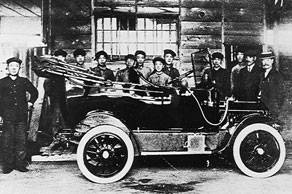 |
Kwaishinsha and the DAT

Around the end of the Meiji period (1868-1912) and the start of the Taisho (1912-26), momentum began to build for manufacturing cars in Japan. And one of the earliest companies to do this was the Kwaishinsha Company an automobile factory, established in 1911 in the Hiroo district of Tokyo. It was just a small workshop with 6 employees, but the founder of the company, Masujiro Hashimoto, had big dreams and even planned to start exporting cars in the future. Hashimoto had studied in the US as an overseas OTJ trainee supported by the Ministry of Agriculture and Commerce, and he had been impressed by the technological expertise and productivity of the American auto industry.
It was in 1914 that the company completed a small passenger car which featured 2-cylinder in line 10ps engine and a top speed of 32km/h. Called the DAT, this was an ambitious engineering challenge that made maximum use of domestically produced components. It caused a stir when it was awarded a copper medal at the Taisho Expo in Ueno, Tokyo, that same year. However, there was still little demand for passenger cars, and a tough round lay ahead. In 1918, Kwaishinsha made a fresh start, manufacturing military vehicles. At the same time, though, it continued development of a small passenger car. After changing its name to Dat Jidosha Seizo Co., it completed work on the DATSON in 1931.
|
 |



The Kwaishinsha Company an automobile factory (circa 1914). The DAT, with its 2-cylinder 10ps engine, was greatly admired and won a copper medal at the Taisho Exposition. It could travel at 32km/h. |
